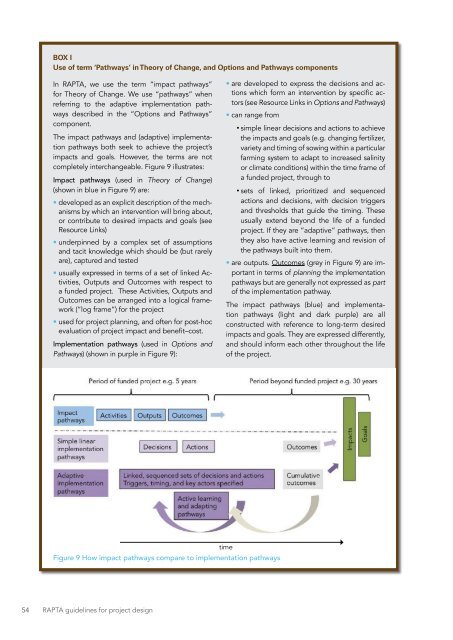DESIGNING PROJECTS IN A RAPIDLY CHANGING WORLD
srun3013fp1
srun3013fp1
Create successful ePaper yourself
Turn your PDF publications into a flip-book with our unique Google optimized e-Paper software.
BOX I<br />
Use of term ‘Pathways’ in Theory of Change, and Options and Pathways components<br />
In RAPTA, we use the term “impact pathways”<br />
for Theory of Change. We use “pathways” when<br />
referring to the adaptive implementation pathways<br />
described in the “Options and Pathways”<br />
component.<br />
The impact pathways and (adaptive) implementation<br />
pathways both seek to achieve the project’s<br />
impacts and goals. However, the terms are not<br />
completely interchangeable. Figure 9 illustrates:<br />
Impact pathways (used in Theory of Change)<br />
(shown in blue in Figure 9) are:<br />
• developed as an explicit description of the mechanisms<br />
by which an intervention will bring about,<br />
or contribute to desired impacts and goals (see<br />
Resource Links)<br />
• underpinned by a complex set of assumptions<br />
and tacit knowledge which should be (but rarely<br />
are), captured and tested<br />
• usually expressed in terms of a set of linked Activities,<br />
Outputs and Outcomes with respect to<br />
a funded project. These Activities, Outputs and<br />
Outcomes can be arranged into a logical framework<br />
(“log frame”) for the project<br />
• used for project planning, and often for post-hoc<br />
evaluation of project impact and benefit–cost.<br />
Implementation pathways (used in Options and<br />
Pathways) (shown in purple in Figure 9):<br />
• are developed to express the decisions and actions<br />
which form an intervention by specific actors<br />
(see Resource Links in Options and Pathways)<br />
• can range from<br />
• simple linear decisions and actions to achieve<br />
the impacts and goals (e.g. changing fertilizer,<br />
variety and timing of sowing within a particular<br />
farming system to adapt to increased salinity<br />
or climate conditions) within the time frame of<br />
a funded project, through to<br />
• sets of linked, prioritized and sequenced<br />
actions and decisions, with decision triggers<br />
and thresholds that guide the timing. These<br />
usually extend beyond the life of a funded<br />
project. If they are “adaptive” pathways, then<br />
they also have active learning and revision of<br />
the pathways built into them.<br />
• are outputs. Outcomes (grey in Figure 9) are important<br />
in terms of planning the implementation<br />
pathways but are generally not expressed as part<br />
of the implementation pathway.<br />
The impact pathways (blue) and implementation<br />
pathways (light and dark purple) are all<br />
constructed with reference to long-term desired<br />
impacts and goals. They are expressed differently,<br />
and should inform each other throughout the life<br />
of the project.<br />
time<br />
Figure 9 How impact pathways compare to implementation pathways<br />
54 RAPTA guidelines for project design


